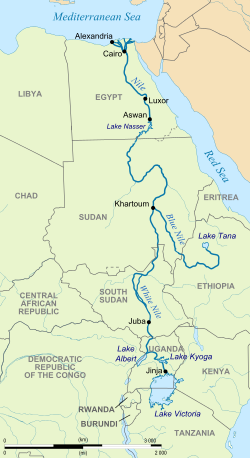
Back فيضان النيل Arabic عيد وفاء النيل ARZ Inundacions del Nil Catalan Nilschwemme German Crecida del Nilo Spanish Crue du Nil French Ambaliyar kogin nilu Hausa הצפת הנילוס HE Banjir Sungai Nil ID Pembanjiran Nil Malay


The flooding of the Nile (commonly referred to as the Inundation) and its silt deposition was a natural cycle first attested in Ancient Egypt. It was of singular importance in the history and culture of Egypt. [1] Governments and administrators of Egypt began constructing infrastructure to control the flooding in the 19th century, and these projects continued into the 20th. The annual flooding cycle in Egypt came to an end in 1970 with the completion of the Aswan High Dam.[citation needed]
The river's predictability and annual deposits in the Nile Valley and Delta[2] made for extraordinarily rich soil—classified today as alluvium on a bed of entisol[3]— enabling the Egyptians to build an empire on the basis of its enormous agricultural wealth and surpluses of cereals which could be stored or traded. Egyptians were one of the first groups of people to practice agriculture on a large scale. This in turn was only possible with their innovation of surface irrigation, also called "basin irrigation", which finally gave rise to the form of Ancient Egyptian agriculture that persisted into the 20th century. Their farming practices allowed them to grow surpluses of both cereals—especially the staple crops wheat and barley—and industrial crops—such as flax for weaving into linen and Nile grass for manufacture into papyrus. By the time of Roman rule, Egypt was one of the most significant sources of wheat in the entire Roman Empire.[1][4][5]
Egyptians have celebrated the flooding since at least early antiquity. Today the annual flooding is commemorated by a two-week holiday called Wafaa El-Nil, beginning on August 15. It is also celebrated in the Coptic Church by ceremonially throwing a martyr's relic into the river, giving it the name "The Martyr's Finger" (Coptic: ⲡⲓⲧⲏⲃ ⲛⲙⲁⲣⲧⲏⲣⲟⲥ, Arabic: Esba` al-shahīd).[citation needed]
- ^ a b "Ancient Egypt | History, Government, Culture, Map, Gods, Religion, Rulers, Art, Writing, & Facts | Britannica". www.britannica.com. 2025-03-31. Retrieved 2025-04-01.
- ^ "Nile Delta". www.wikidata.org. Retrieved 2025-04-01.
- ^ Williams, Martin, ed. (2019), "Geology and Soils", The Nile Basin: Quaternary Geology, Geomorphology and Prehistoric Environments, Cambridge: Cambridge University Press, pp. 33–58, ISBN 978-1-107-17919-6, retrieved 2025-03-31
- ^ Huebner, Sabine R. (2020-11-01). "Climate Change in the Breadbasket of the Roman Empire—Explaining the Decline of the Fayum Villages in the Third Century CE". Studies in Late Antiquity. 4 (4): 486–518. doi:10.1525/sla.2020.4.4.486. ISSN 2470-6469.
- ^ "Nile River | Delta, Map, Basin, Length, Facts, Definition, Map, History, & Location | Britannica". www.britannica.com. 2025-03-31. Retrieved 2025-04-01.
© MMXXIII Rich X Search. We shall prevail. All rights reserved. Rich X Search